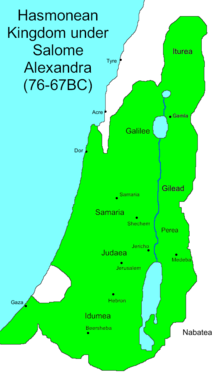Hyrcanus II
| Hyrcanus II | |
|---|---|
| |
 Hyrcanus fromGuillaume Rouillé'sPromptuarii Iconum Insigniorum | |
| King of Judaea | |
| Reign | c. 67 – 66 BCE |
| Predecessor | Salome Alexandra |
| Successor | Aristobulus II |
| High Priest of Judaea | |
| Reign | c. 76 – 66 BCE |
| Predecessor | Alexander Jannaeus |
| Successor | Aristobulus II |
| Reign | 63 – 40 BCE |
| Predecessor | Aristobulus II |
| Successor | Antigonus II Mattathias |
| Ethnarch of Judaea | |
| Reign | c. 47 – 40 BCE |
| Successor | Office abolished |
| Issue | Alexandra the Maccabee |
| Dynasty | Hasmonean |
| Father | Alexander Jannaeus |
| Mother | Salome Alexandra |
| Religion | Judaism |

John Hyrcanus II(/hərˈkeɪnəs/,Hebrew:יוחנן הרקנוסYohanan Hurqanos;died 30 BCE), a member of theHasmonean dynasty,was for a long time the JewishHigh Priestin the 1st century BCE. He was also briefly King of Judea 67–66 BCE and then theethnarch(ruler) of Judea, probably over the period 47–40 BCE.[1]
Accession[edit]
Hyrcanus was the eldest son ofAlexander Jannaeus,King and High Priest, andAlexandra Salome.After the death of Alexander in 76 BCE, his widow succeeded to the rule of Judea and installed her elder son Hyrcanus as High Priest. Alexander had numerous conflicts with thePharisees.[2]However, Hyrcanus was supported by the Pharisees, especially later in his tenure.[3]
When Salome died in 67 BCE, she named Hyrcanus as her successor as ruler of Judea as well,[4]but soon he and his younger brother,Aristobulus II,began fighting over who had the right to the throne.
Deposition[edit]
Hyrcanus had scarcely reigned three months when Aristobulus II rose in rebellion. Hyrcanus advanced against him at the head of hismercenariesand his followers. The brothers met in a battle nearJerichowith many of Hyrcanus' soldiers going over to Aristobulus II, and thereby giving victory to the latter.[4][5]
Hyrcanus took refuge in the citadel ofJerusalem;but the capture of theTempleby Aristobulus II compelled Hyrcanus to surrender. A peace was then concluded in which Hyrcanus was to renounce the throne and the office of high priest, but was to enjoy the revenues of the latter office.[6]
Alliance with the Nabataeans[edit]
This agreement did not last. Hyrcanus feared that Aristobulus was planning his death. Such fears were furthered by Hyrcanus' adviser,Antipater the Idumean.According to Josephus, Antipater sought to control Judea by putting the weak Hyrcanus back onto the throne.[4]Hyrcanus took refuge withAretas III,King of theNabataeans,who had been bribed by Antipater into supporting Hyrcanus' cause through the promise of returning Arabian towns taken by the Hasmoneans.
The Nabataeans advanced toward Jerusalem with an army of 50,000, took the city and besieged the Temple where Aristobulus had taken refuge for several months. During the siege,Josephusstates that the adherents of Hyrcanus stoned the piousOnias(Honi ha'Me'agel, also Khoni or Choni ha-Me'agel), who had refused to pray for the demise of their opponents, and further angered the priests who were fighting along with Aristobulus by selling them cattle for the paschal sacrifice for the enormous price of one thousanddrachmaeand then refused to deliver the promised animals for the sacrifice.(Antiquities of the JewsBook 14, 2:2)[7]
Roman intervention[edit]

During the Roman civil war, generalPompeydefeated armies of the kingdoms ofPontusand theSeleucids.He sent his deputyMarcus Aemilius Scaurusto take possession of Seleucid Syria.
As the Hasmoneans were allies of the Romans, both brothers appealed to Scaurus, each endeavouring through gifts and promises to win him over to his side. Scaurus, moved by a gift of 400 talents, decided in favour of Aristobulus and ordered Aretas to withdraw his army. During his retreat, the Nabateans suffered a crushing defeat at the hands of Aristobulus. Scaurus returned to Damascus.[8]
When Pompey arrived in Syria in 63 BCE, both brothers and a third party that desired the removal of the entire dynasty (according to some sources, these may have been the representatives of the Pharisees), sent their delegates to Pompey, who delayed making a decision. He favoured Hyrcanus over Aristobulus, deeming the elder, weaker brother a more reliable ally of the Roman Republic.
Aristobulus, suspicious of Pompey's intentions, entrenched himself in the fortress ofAlexandrium,but when the Roman army approached Judea, he surrendered and undertook to deliver Jerusalem over to them. However, since many of his followers were unwilling to open the gates, the Romansbesieged and capturedthe city by force, badly damaging the city and the temple. Aristobulus was taken to Rome a prisoner and Hyrcanus restored as high priest in Jerusalem.[9]
Restoration[edit]
By around 63 BCE, Hyrcanus had been restored to his position as High Priest but not to the Kingship. Political authority rested with the Romans whose interests were represented byAntipater,who primarily promoted the interests of his own house. In 47 BCE,Julius Caesarrestored some political authority to Hyrcanus by appointing himethnarch.This however had little practical effect, since Hyrcanus yielded to Antipater in everything.[8]
Exile[edit]
In 40 BCE, Aristobulus' sonAntigonus Mattathiasallied himself with theParthiansand was proclaimed King and High Priest.[8]Hyrcanus was seized and his ears mutilated (according to Josephus, Antigonus bit his uncle's ears off) to make him permanently ineligible for the priesthood.
Then Hyrcanus was taken by the Parthians into captivity inBabylonia,[10]where he lived for four years amid theBabylonian Jews,who paid him every mark of respect.
Return to Jerusalem and death[edit]
In 36 BCE,Herod I,who had vanquished Antigonus with Roman help and feared that Hyrcanus might persuade the Parthians to help him regain the throne, invited the former High Priest to return to Jerusalem. Hyrcanus accepted and Herod received him with every mark of respect, assigning to him the first place at his table and the presidency of the state council.
However, in 30 BCE Herod charged Hyrcanus with plotting with the Nabateans and put him to death. Josephus states that Hyrcanus was 80 years old at the time of his death.
Biblical scholar Gregory Doudna proposed in 2013 that Hyrcanus II was the figure known as theTeacher of Righteousnessin theQumran Scrolls.[11][12]According to Doudna, Hyrcanus II’s sectarian orientation is now generally understood to have beenSadducee.
See also[edit]
- Hasmonean coinage
- Hyrcanus inscription
- Hyrcania
- Siege of Jerusalem (disambiguation),list of sieges for, and battles of, Jerusalem
References[edit]
- ^Shatzman, Israel (January 1, 1991).The Armies of the Hasmonaeans and Herod– Google Knihy.ISBN9783161456176.Retrieved2016-10-20.
- ^Alexander Jannaeusjewishencyclopedia
- ^Hyrcanus IIjewishencyclopedia
- ^abc"Hyrcanus II",Jewish Encyclopedia "
- ^Josephus(Antiquities14.1.2);Babylonian Talmud(Baba Kama82b)
- ^Schürer,"Gesch." i. 291, note 2
- ^Josephus Flavius."The Antiquities of the Jews".Retrieved5 April2015.
- ^abcHoehner, H.W., "Hasmoneans",International Standard Bible Encyclopedia: E-J,Geoffrey W. Bromiley (ed.), Wm. B. Eerdmans Publishing, (1995)
- ^Rocca, Samuel (20 May 2008).Rocca, Samuel.The Forts of Judaea 168 BC-AD 73: From the Maccabees to the Fall of Masada,Osprey Publishing, (2008).Bloomsbury USA.ISBN9781846031717.Archived fromthe originalon 2016-05-03.Retrieved2016-10-18.
- ^Hammond & Goodman 2017,p. xvii.
- ^David Stacey, Gregory Doudna,Qumran Revisited: A Reassessment of the Archaeology of the Site and its Texts.BAR international series, 2520. Oxford: Archaeopress, 2013.ISBN9781407311388
- ^Gregory Doudna,A Narrative Argument that the Teacher of Righteousness was Hyrcanus II.Excerpted from pp. 95-107 of the bookArchived2021-03-01 at theWayback Machine
 This article incorporates text from a publication now in thepublic domain:Singer, Isidore;et al., eds. (1901–1906)."Hyrcanus II".The Jewish Encyclopedia.New York: Funk & Wagnalls.
This article incorporates text from a publication now in thepublic domain:Singer, Isidore;et al., eds. (1901–1906)."Hyrcanus II".The Jewish Encyclopedia.New York: Funk & Wagnalls.
Bibliography[edit]
Sources[edit]
- Hammond, Martin; Goodman, Martin, eds. (2017).The Jewish War, by Josephus.Oxford: Oxford University Press.ISBN978-0191057595.
- Flavius Josephus,Antiquities of the Jews,book XIV, 5-13.
- Flavius Josephus,The Jewish War,book I, 8-13.
Literature[edit]
- Heinrich Ewald,Geschichte des Volkes Israel, volume IV, p. 524ff.
- Heinrich Graetz,History of the Jews, volume III, p. 167ff.
- Hitzig[clarification needed],Geschichte des Volkes Israel, volume II, p. 500ff.
- Emil Schürer,Geschichte des judischen Volks im Zeitalter Jesu Christi, volume I, p. 338 et seq.
